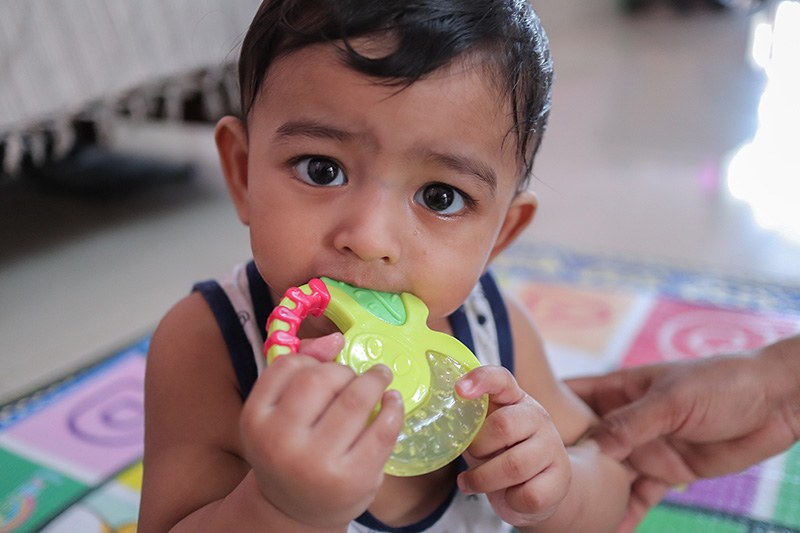Biting is typical behavior for children up to about 3 years of age. The first step to eliminate biting is to discover why that child bites.

Close-up of an older infant is holding a teether with two hands and biting it.
Why children bite
Exploring
Young children learn by seeing, hearing, touching, smelling, and tasting. If you give an infant a toy, one of the first things they do is put it in their mouth. To a very young child, biting a person and biting a toy are the same—it’s a way to learn about the world.
Teething
When new teeth come in, a child’s gums may be swollen and very tender. Chewing sometimes helps the pain. Chewing on a person may feel just as good on sore gums as chewing on a teething ring.
Cause and effect
Around the age of 12 months, infants learn that when they do one thing, something else happens. When they push a button on a toy, something pops up. When they drop a spoon from the high chair, it bangs on the floor. They may also find that when they bite someone, that person reacts!
Getting attention
Older toddlers may bite other children to get attention from other children or adults. The attention may be positive or negative. Positive is good attention (“You have sore gums, don’t you, Sweetie?”). Negative attention is not so good (“No!” or “You are in trouble now!” or punishing). For children who bite for attention, negative attention may be better than no attention! A lonely-feeling child soon finds out that biting is a quick way to become the center of attention.
Copy cats
Children love to do the same things they see others doing. When a child sees another child biting, they want to do the same thing. This is why an adult should never bite a child back. Children who see adults biting others think it’s OK for them to bite too.
It's mine
Toddlers are too young to share. They are very self-centered, and are busy learning about how to control their world. Biting is a quick way to take over a toy or to move another child out of the way.
Learning words
Toddlers are learning how to speak. They don’t always know the words that they need to say. If they can’t find the words to say what they want, they may bite, hit, or push other children.
Times of stress
Children who are bored, tired, or hungry may bite out of stress. Children going through hard family times, such as the divorce of parents, a new baby at home, or moving may be more stressed and start to bite others.
It’s typical behavior for young children to bite.
What can you do?
Think about the times when a child bites. Ask yourself some questions:
- When did the biting take place?
- Who did the biting?
- Who was bitten?
- Where did it happen?
- What happened before and after the biting?
Teach children to use words instead of biting.
Stop biting before it happens
If you think a child is biting because they are exploring or teething, give them a cloth or teething ring to chew on.
If children seem to fight over the same toy shopping cart all the time, buy another shopping cart. That way two children can play with the same toy at the same time. Teach children to use their words to tell others what they want. “Tell John ‘No’ if he tries to take away your truck.”
If a child bites more when they are tired or hungry, change the schedule for the day. Offer a mid-morning snack, or move lunchtime up. Arrange for an earlier naptime, or a calm, quiet activity.
If you think a child is biting to get attention or from stress, spend some extra time with that child. Try reading a book together, playing together, or rolling a ball back and forth to give this child some positive attention.
Stay very close to a child who has bitten others. Be ready to step in to help if you think they may bite another child.
Praise children
Tell children when they are behaving the way you want them to. This will help children know the kind of behavior you like. “John, I like the way you and Mary are building together.” “Sue, thank you for asking Carrie before you took the doll.”
Handling biting
When a child bites, move them away from the other children. Use your voice and face to show them you do not like biting. Get down on the child’s level and look into their eyes. Tell them, “No biting. Biting hurts. Lisa is crying. I won’t let you bite Lisa or another child.”
This is a good time to teach children to use their words. “You can tell Lisa with your words that you don’t want them to take your toy. Say, ‛Lisa, that’s mine.”
Ask the child who did the biting if they would like to help wash, bandage, and comfort the victim. The biter learns kindness skills when they help to comfort the bitten child.
Stop toy fighting — have two of the same favorite toys.
Talking with parents
Talk with the parents of the child who is biting and the parents of the child who was bitten. Tell parents that biting is normal in young children, but not the kind of behavior you want. Talk about the reasons that children bite and what you are doing to help the child stop biting. Tell parents it is important that they handle biting at home in the same way so the child understands that they may not bite others at home or in child care.
Dealing with a biter is ongoing work. Remember, you’re helping this child learn to control their behavior.

